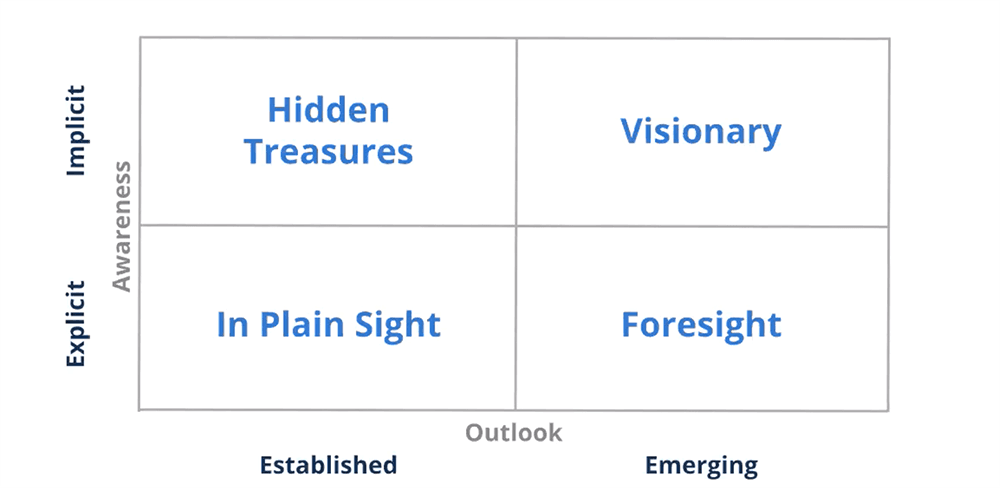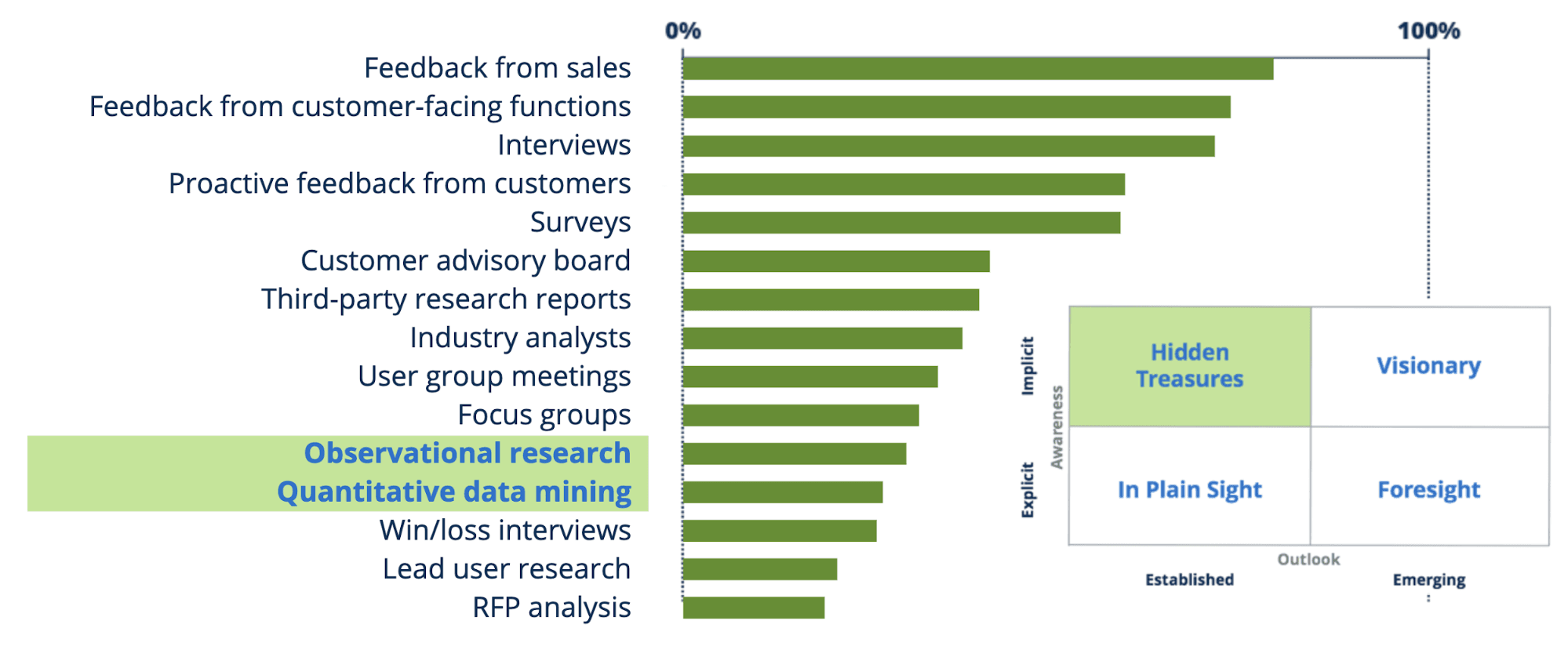5 Ways to Make Smarter Product Bets with Product Intelligence
High-performing businesses are 34% more likely to have an above-average understanding of customer needs. Here’s why.
McKinsey found that half of digital leaders collect and analyze customer data weekly, compared to just 16% of lower-performing customers that do the same. The takeaway? If you want to be a digital leader, start prioritizing customer data.
Research by Jeff Lash, Forrester’s VP and Group Director of Product Management, aligns with McKinsey’s findings—and so does our own history of bringing customer insights to businesses around the world. Which is why we teamed up with Lash for a webinar on how customer insights connect teams to the people who use their products and help deliver better business results.
The webinar was full of actionable information. We distilled it down to the five key takeaways you need to know about customer insights.
1. Make customer insights a priority, not an afterthought.
At the end of the day, product management is about connecting customer and business needs: understanding what your customers need, how they use your products and services, and how addressing those needs drives business impact.
So, it should come as no surprise that high-performing product management organizations prioritize customer insights. In fact, according to Forrester, high-performing teams are:
- 34% more likely to have an above-average understanding of customer needs
- 42% more likely to have a customer- and market-focused product lifecycle process
- 58% more likely to have a formal customer needs program
As Lash pointed out during the webinar, this validates what most of us feel at a gut level. To succeed, we need to understand our customers. And the way to arrive at that understanding is through customer insights.
2. Surprise and delight your customers.
Not all customer needs are created equal. That’s why Lash recommends mapping customer needs in a quadrant chart.
On one axis, you’ve got customers’ awareness of their needs. Are the needs explicit things they’ve asked you for or implicit things you can infer from their behavior?
The other axis is time. Are the needs established in the here and now or emerging as a future need because of changing regulations, needs, or industry trends?
Needs that are explicit and established are what Lash calls “in plain sight.” They’re the low-hanging fruit. These are what your customer expects from you. Your baseline opportunities.
Needs that are implicit and established, on the other hand, are what he calls “hidden treasures.” They’re opportunities in the here and now, but customers can’t or won’t articulate them for you and they often go unnoticed by product teams. Here, you have an opportunity to really surprise and delight customers.

Despite this opportunity, 72% of companies spend the majority of their time on explicit needs, and 58% think those needs have a huge business impact. Forty-five percent spend little to no time on implicit needs, but 83% expect them to have a huge business impact, according to research by SiriusDecisions in their Process for Understanding Customer Needs for Innovation survey, 2016.

Based on those numbers, the opportunity to be one of the few businesses in your industry surprising and delighting customers is pretty significant.
3. Dig deeper into your data.
Forrester asked businesses how they collected customer data (in order to surface customer insights), and the top answers weren’t surprising, but they still told an interesting story. Most data was collected from feedback from customer-facing teams, customer interviews, insights, and surveys.
But once Forrester collected this data, they took it a step further, mapping each type of data collection to a quadrant on their chart. They found that the top five answers fell into the in-plain-sight category. And quantitative data mining was the primary method that led to uncovering hidden revelations, but it was a less-used method from companies than their explicit data counterparts.

Here’s an example: Say you have a client who is a product manager of online video-editing software. The top feature request for their product is the ability to export videos in multiple formats. Based on that, you’d think adding that feature would be a no-brainer.
But a deeper dig into the data reveals that those asking for the ability to export video in multiple formats have a low retention rate (65%). A group of the happiest clients, with a 95% retention rate, are asking for other new features — watermarks and share options.
Based on this deeper data, you might still choose to prioritize the unhappy group and build a new feature that lets them export in any format to their hearts’ desire. Or you might choose to focus your energy on your happy users, keep that retention high, and capitalize on their likelihood of referring new happy customers.
There’s no single right answer here. But having more data gives you a better sense of not just what you need to do but also why you should do it. Are high-lifetime-value customers your priority right now, or are you trying to lessen your churn? Who’s asking for new features? Are they likely to be high-lifetime-value customers?
Digging deeper gives you the insights you need to make educated decisions.
4. Personalize for your customer’s sake—and your own.
Personalization through customer insights can be a huge win for a company’s bottom line. Take Amazon as an example. They attribute 35% of their sales to their personalization engine.
But one of the big wins talked about less often is that personalization, when done well, takes care of your customers. It’s empathetic and respectful. It responds to users’ specific needs and behaviors. And in taking care of your customers, it also drives business results.
One good example of this is Amplitude customer Rappi, a Colombian delivery startup that covers everything from restaurant orders to groceries to medication. When they came to Amplitude, their goal was to provide personalized experiences that improve conversion.
To get there, they created a new conversion team focused on driving users through critical funnels. Rappi empowered that team—and the rest of their organization—with customer data; 240 people from 10 different teams are using Amplitude on a weekly basis to better understand and personalize for customers.
The result of this new data-driven personalization? Rappi decreased the time it takes to diagnose a bug from three weeks to one day and increased revenue from first-time orders by 10%.
Let user behavior determine which experiences your product should offer.
5. Collaborate around data storytelling.
There’s a reason the art of storytelling has been with humanity for millennia. Stories create a shared sense of purpose. They help us understand the world. They foster connection.
That’s true of storytelling through the ages, and it’s true of the data-driven storytelling used in businesses today. It brings teams together, supports collaboration, and creates shared purpose and understanding of the customer and their experience with your product.
Even better, the collaborative culture supported by those stories is tied directly to the success of your products. In fact, 78% of product managers who see improving collaboration as one of their top three responsibilities experienced low product failure rates, according to one study.
Of course, to be able to collaborate around data storytelling, you need to understand the story in the data—which is where data visualization comes in.
Data visualization is an important part of exploratory analysis and storytelling. Business Intelligence (BI) tools and Excel are great for creating beautiful visualizations of trends over time, but they’re not always great at putting your customers at the center of the story. And while they are powerful for building customized dashboards, they leave everything in the hands of analysts instead of empowering your teams directly.
For real results like those outlined in the webinar, teams need to build analyses as they uncover insights step by step—uncovering their larger data story with each step and moving away from data silos to a culture driven by shared insight into customer behavior and product experience.

Consistent, real-time team learning has the power to change not only your product, but how your teams work. With more data at their fingertips, teams like iflix now have faster decision velocity and higher decision quality.
As iflix’s Global Head of Product Thomas Peterson notes:
“My favorite feature within Amplitude is Notebooks. Notebooks are a really great way to create a narrative around data. There’s so much work happening all the time that it’s sometimes hard to remember the full context of the data you’re looking at. Notebooks lets you draw connections to other data points throughout the business to tell a holistic story you can share with your team.”Thomas Peterson, Global Head of Product at iflix
Product Intelligence and Product Engagement are Game Changers
Ultimately, this leads us to the technology solution. Product teams are responsible for understanding how their customers engage with the product, translating insights into product investments, building experiences that drive outcomes, and measuring and broadcasting the impact. It’s an increasingly essential role as the digital economy becomes more complex.
To be successful, a new crop of technologies have emerged to empower digital teams to use customer behavior to build great experiences. Product intelligence—the combination of product analytics, data management, and behavioral targeting that empowers teams to use customer insights to drive conversion and retention—is at the core of this purpose. With a product intelligence platform like Amplitude, teams can surface the analytics that accelerate and improve decision making.
Product intelligence goes a step beyond normal analytics by enabling action. That’s why Amplitude integrates with customer engagement platforms like Braze, Iterable, Airship, and Intercom. In Amplitude, your team can gather insights into how certain cohorts of customers use your product, and then use an integration to drive targeted interventions aimed at improving engagement.

Product Intelligence and engagement allow teams to monitor product and customer data and take action in the product experience via your roadmap or omnichannel touchpoints.
If the research from Forrester or the Amplitude customer stories resonate, we’ve got more insights and real-world examples in the on-demand webinar recording. You should check it out here. And if customer insights are a priority for your business? Check out our product demo to get a sense of how you can explore data for customer insights.

John Hurley
Former VP of Product Marketing, Amplitude
John formerly led the product marketing team at Amplitude where he worked alongside teams, customers, and partners to advance the Amplitude vision.
More from John




